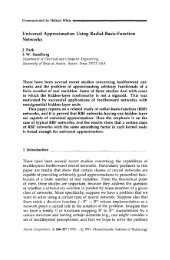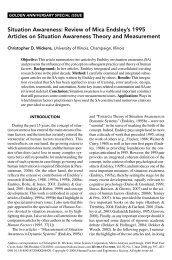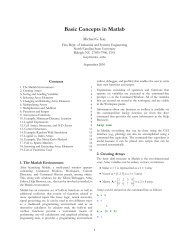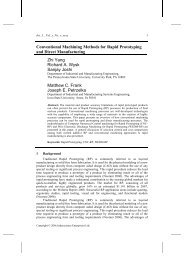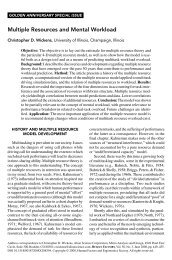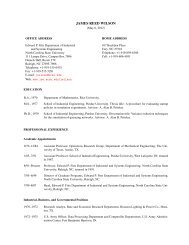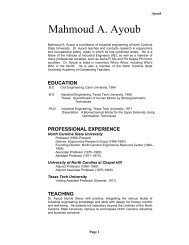Material Handling Equipment - Industrial and Systems Engineering
Material Handling Equipment - Industrial and Systems Engineering
Material Handling Equipment - Industrial and Systems Engineering
Create successful ePaper yourself
Turn your PDF publications into a flip-book with our unique Google optimized e-Paper software.
MATERIAL HANDLING EQUIPMENTUnlike the Manufacturer’s Problem, the Distributor’s Problem is nonrepetitive (i.e., it requires aunique solution for each pallet loaded) ⇒ one should be willing to spend more time <strong>and</strong> effortto find a good solution to the Manufacturer’s Problem as compared to the Distributor’s Problem.Manufacturer’s Problem ⇒ use of automatic stripper plate palletizer possibleDistributor’s Problem ⇒ manual or robotic (pick <strong>and</strong> place) palletizationBoth problems are difficult optimization problems to solve (they are, in fact, both “NP-hard”),even with the following restrictions that are usually assumed:1. All items <strong>and</strong> pallets are rectangular.2. Items are placed orthogonally on a pallet (i.e., all item edges are parallel to pallet edges).4. Positioning <strong>Equipment</strong>Positioning equipment (see Table 2) is used to h<strong>and</strong>le material at a single location. It can be usedat a workplace to feed, orient, load/unload, or otherwise manipulate materials so that are in thecorrect position for subsequent h<strong>and</strong>ling, machining, transport, or storage. In many cases,positioning equipment is required for <strong>and</strong> can be justified by the ergonomic requirements of atask. As compared to manual h<strong>and</strong>ling, the use of positioning equipment can provide thefollowing benefits: 12• raise the productivity of each worker when the frequency of h<strong>and</strong>ling is high,• improve product quality <strong>and</strong> limit damage to materials <strong>and</strong> equipment when the itemh<strong>and</strong>led is heavy or awkward to hold <strong>and</strong> damage is likely through human error orinattention, <strong>and</strong>• reduce fatigue <strong>and</strong> injuries when the environment is hazardous or inaccessible.Table 6. Positioning <strong>Equipment</strong>1. Manual (no equipment)2. Lift/tilt/turn table3. Dock leveler4. Ball transfer table5. Rotary index table6. Parts feeder7. Air film device8. Hoist9. Balancer10. Manipulator(a) Rigid-link manipulator(b) Articulated jib crane manipulator(c) Vacuum manipulator11. <strong>Industrial</strong> robot1. Manual (no equipment)Under ideal circumstances, maximum recommended weight for manual lifting to avoid backinjuries is 51 lbs.Recommendation based on NIOSH (National Institute for Occupational Safety <strong>and</strong> Health) 199120



